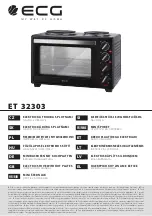
WESTFIRE · WF
32
WESTFIRE · WF
32
7
windy days. The damper must not be able to close fully, and must have a clearance of at least 20 cm2 of the total
clear opening of the pipe.
Other types of dampers may also be used, such as allowing air to enter the chimney by bypassing the stove.
More than 1 appliance on a flue system is not allowed in the UK under any circumstance.
OPerating instruCtiOns
The heat-resistant paint on the stove will harden the first time you light up the appliance. This process produces a
good deal of smoke and odour, and the room should therefore be well ventilated.
The stove door should be kept open during the first couple of firings and only closed once the stove has cooled
down to prevent the packing cord around the door from sticking and coming away from the door.
Once the heat-resistant paint has hardened,
the stove door must be kept closed
except when lighting the stove,
adding firewood or removing ash in order to prevent flue gas from escaping.
Before lighting the stove, open the air system by pulling the air lever out fully and opening the draft control on
the left-hand side.
Firelighters should ideally be used when lighting the stove. Never use methylated spirit, petrol or other
flammable liquids to light your stove! Place a few smaller pieces of wood in the stove on top of the firelighters.
Once the fire has caught, add two pieces of wood measuring approx. 33 cm with a combined weight of approx.
1.6 kg. After approx. five minutes, close the draft control and close the air lever in the centre approx. 70%. At
nominal heat output, expect to refuel your stove approx. once an hour.
For slow burning/reduced heat output simply add smaller quantities of wood less often, and close the air lever in
the centre more than 70%.
WF 32 is designed for intermittent combustion (wood must be added often and the stove is not designed for
24-hour use).
WF 32 is equipped with a control valve for secondary air designed to ensure a plentiful supply of oxygen
during firing.
When lit, the stove will get very hot and due care must therefore be exercised. Please use a glove when
operating levers and dampers.
in the event of a chimney fire:
Close the air damper and the stove door, and call 999 (112) or your local fire
department.
BasiC POsitiOn OF daMPers during OPeratiOn
You will need to become familiar with your stove in order to be able to regulate the secondary air intake correctly,
as factors such as the quality and height of your chimney, the quality of your fuel and the external conditions
play a large role. It is easy to see whether the stove is functioning correctly, however. Incomplete combustion
may lead to a build-up of hard, shiny soot on the inside of your stove. This is prevented by the introduction of
additional secondary air.
It is important to check the draft conditions before lighting your stove. This may be done, for instance, by
crumpling a piece of newspaper, placing it in the combustion chamber and lighting it. The draft conditions are
good if the smoke is drawn away through the chimney.
FueL
Never use toxic wood such as chipboard or impregnated or painted wood. Always use dry firewood. The dryness
of the firewood plays an important role since the use of wet wood results in poor fuel economy and may cause
tarry soot to form.
Newly cut wood contains 60–70% water, making it totally unsuitable for use as firewood.
Newly cut wood should be stacked and air dried under cover for two years before being used as firewood.
secondary air
WF 32
30 % open
uk






















